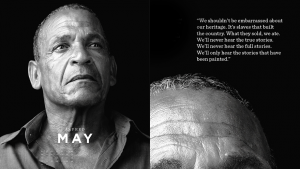From the Series
In his 20-year career in advertising, through the turbulence of financial slumps and the victories of ground-breaking campaigns, Chris Gotz has never lost sight of the special magic that is creativity.
The perennial question of staying inspired and producing good work has bedeviled creatives in the ad industry from its very beginnings. It all begins, says the chief creative officer of Ogilvy & Mather South Africa, with holding on to the innocence and unbridled expression of childhood.
“At school, children’s dreams are brutally scooped out of them to make space for nine times table,” he tells the audience at Design Indaba Conference 2014. “We live in a world where writing stories, drawing pictures and dancing are really cool for children but are largely frowned upon as you get older.
The challenge to all creatives everywhere, says Gotz, is not to bow down to the obvious functionality – “to maths and physics and science” – that the world demands.
His presentation – a kind of meditation on the nature of creativity – presents a number of successful campaigns by Ogilvy & Mather South Africa that highlight the power of creative thinking to come up with innovative solutions.
Build beautiful monsters
Under Gotz and managing director Gavin Levinsohn, Ogilvy & Mather set out on a course to “build beautiful monsters” – campaigns that integrate digital technology, real life, events and multimedia such as video: “These are the holy grail of advertising agencies at the moment – big, seamless, multidisciplinary ideas or projects.”
It’s an approach that requires massive amounts of collaboration, an aspect of creativity that Gotz has much to say about. “Collaboration between creative people is something you have to force and encourage,” he says.
Creative people are independent by nature, very territorial and often quite precious.
Pooling creative skills was a key part of Ogilvy & Mather’s reinvention after the financial slump of 2008. Its first foray into creating an integrated campaign was for Volkswagen’s CitiGolf brand, the best-selling car in South Africa’s history.
After 25 years, Volkswagen had decided to stop making CitiGolfs so its brief to the agency was to bid the car farwell. The client asked Ogilvy to create a “greatest hits” compilation of its commercials made over the year, but instead the agency turned the spotlight on the very last model rolled off the production line. They took it on a tour around the country, inviting ordinary people to sign it and say their goodbyes. In the process, they captured the imagination of the entire country.
A website tracked the car’s journey live online with daily videos, photos and diary entries. Goodbye Citi became one of the fastest growing Facebook pages in South African history, with 60 000 people following its journey online and a record R12.6 million in free publicity generated.
Sensing the possible
An important part of being creative, says Gotz, is feeling full of possibility. “That’s the blank cheque you’ve got to give every single person who works in your agency. Creatives need to face their fear, take risks, stay open to the moment, not get lost in the process.”
The creative temperament has its pitfalls, he continues.
Creatives get down very easily. We get winded and bogged down by process. Often we get becalmed.
“We should stay alert. Our radar should be up to what might happen at any given moment.”
Staying open to new ideas that may arise in the process of creating something – even if it results in a change of direction – is key. This played a huge role in Ogilvy’s campaign for Carling Black Label. The creative team came up with idea of sponsoring a soccer match between Kaizer Chiefs and Orlando Pirates and to get a fan from each of the teams to play coach on the day. But while workshopping the idea, another idea surfaced: to let all the fans be coach by giving input on social media leading up to the game and making live substitutions via SMS to a number under the cap of their Carling Black Label beer.
The campaign ignited furious debate in the media between fans, journalists and even coaches. It garnered 10.5 million votes in seven weeks, 85,000 fans attended the game and R83 million worth of publicity was generated.
Accidental poetry
With all the distractions of mobile technology, he worries that our ability to notice moments of accidental poetry is shrinking. We are relying more and more on information we find online.
I think we are suffering from a deficit of primary evidence, Gotz says.
“A lot of the stuff we discover on the Web has been put there by somebody else, it’s been curated by somebody else. We didn’t actually find it. We need to get out there and look at stuff a little bit more.”
Creatives need to be sharply attuned to their surroundings, he says. Ogilvy’s campaign for a Volkswagen brand of eco-friendly engines called Bluemotion Technologies grew out of sharp observation to the contradictions in the client’s brief. Bluemotion wanted a magazine ad but the agency felt it was an inefficient medium that didn’t embody the brand’s sustainable values. So, instead, it created a label that was inserted into subscribers’ copies of Car magazine that readers could stick onto the front of the magazine when they were done reading it, and mail it away to be recycled. It was ultimately rolled out to nearly 800,000 magazines.
Storytelling to storymaking
Working on these types of integrated campaigns resulted in Ogilvy changing the way they approached narrative structure. “Instead of holding up a story to the reader or consumer and asking ‘What do you think of this?’, we asked them to step into the story,” says Gotz.
We started to build stories up and over so they were in the work rather than just looking at the work.
This kind of consumer involvement is much more rewarding, he notes.
For Volkswagen’s 60th birthday anniversary, the client’s brief was to create a participatory digital campaign. They wanted to show how much Volkswagen cars are embedded into the fabric of our society and how many there are on the road.
Ogilvy came up with the “Volkswagen Street Quest”, an online game with weekly competitions for users to find and pin Volkswagen cars in their own cities using Google Street View technology and social media. It culminated in a grand final where weekly winners came to Cape Town to compete in a real-life hunt to spot Volkswagen cars on the streets. The game was an instant success, with more than 90,000 pins in the first week alone, more than 400,000 pins in total and a 700% increase in engagement on Volkswagen’s Facebook page.
Return to innocence
Being creative in the advertising industry requires staying open to possibility, says Gotz. It’s easy to fall into the trap of shooting down ideas, becoming cynical and all-knowing.
“But I think there is another way to be: you can be naïve and innocent,” he concludes. “You can believe in the religion of ideas, walk into your office every day and know that you can have an idea that has the power to change everything. For me that’s a much better way to be.”










